Understanding the Importance of Soil Health for a Lush Lawn
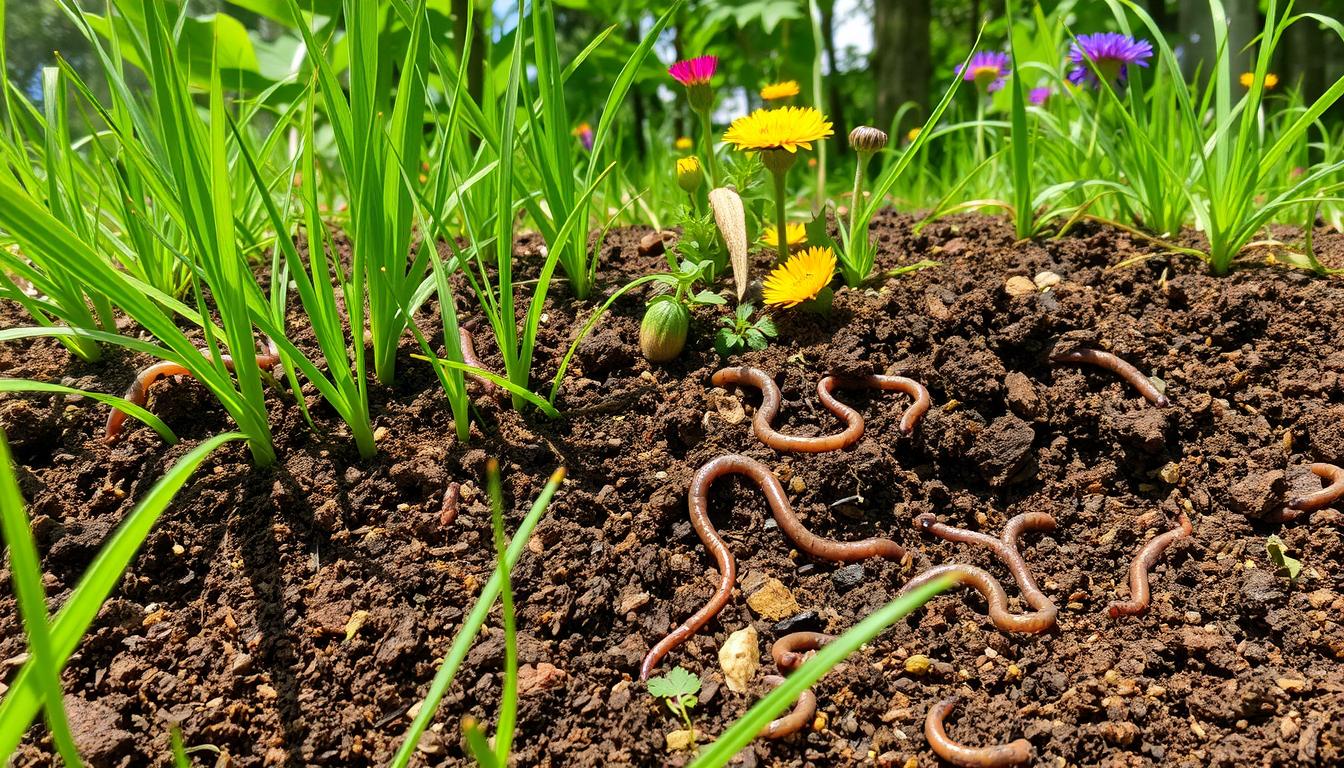
Did you know a lush lawn starts with the soil, not just the grass? Studies show soil health is key, making up to 80% of a lawn’s vitality. This highlights how vital soil is for a green, healthy outdoor space.
As a homeowner, I’ve found that a beautiful lawn needs good soil. The soil’s makeup, pH, and health affect grass growth and look. Learning about soil health has helped me grow a lawn that’s not just pretty but also strong and green.
Key Takeaways:
- Soil health accounts for up to 80% of a lawn’s overall vitality and appearance.
- Understanding soil composition, pH balance, and overall health is crucial for maintaining a thriving lawn.
- Healthy soil supports vigorous grass growth, disease resistance, and ecological sustainability.
- Incorporating organic matter and proper aeration can significantly improve soil structure and fertility.
- Choosing the right grass species for your soil type can optimize lawn performance and resilience.
The Link between Soil Health and Lawn Care
Your lawn’s health depends on the soil beneath it. Soil is essential for your lawn to grow well. It helps with nutrient uptake, water, and root growth. Knowing about soil is crucial for a green, healthy lawn.
Soil Composition’s Crucial Role in Lawn Maintenance
Soil structure, made of sand, silt, and clay, affects your lawn’s health. Good soil, like loam, drains well but holds enough moisture. Bad soil can cause thin grass, water problems, and weeds.
Key Factors Influencing Soil Health
- Soil pH: A pH between 6.2 to 7.0 is best for grass growth.
- Organic Matter: Adding compost or manure improves soil and supports microbes.
- Nutrient Levels: The right mix of nutrients, like nitrogen and potassium, helps grass grow strong.
- Microbial Activity: Good soil has many beneficial microbes that help with nutrient cycling and structure.
- Soil Compaction: Too much foot traffic or machinery can harm soil, making it hard for grass to grow.
Knowing what makes soil healthy helps homeowners care for their lawns better. Testing soil, aerating, and using organic amendments are key. They ensure your lawn gets what it needs to stay healthy and green.
“Healthy soil is the foundation for a beautiful, low-maintenance lawn that can withstand environmental stresses and provide years of enjoyment.”
Understanding Soil Types and their Impact
A healthy lawn starts with knowing your soil type. Soil type affects how water drains, nutrients are available, and roots grow. Let’s look at the three main soil types – sandy soil, loamy soil, and clay soil. We’ll see how each one is different and help you figure out your yard’s soil. This way, you can care for your lawn better.
Sandy Soil Characteristics
Sandy soils have big, coarse particles. They drain water well but can’t hold onto it or nutrients. Sandy soils warm up fast in spring but dry out quickly. Keeping the soil moist and adding nutrients often is key for a green lawn in sandy soil.
Loamy Soil Benefits
Loamy soil is a mix of sand, silt, and clay. It’s perfect for lawns because it holds air, water, and nutrients well. Lawns in loamy soil need less care and can handle stress better.
Clay Soil Challenges
Clay soils are dense and slow to drain. They hold moisture and nutrients but can block air and root growth. To improve clay soil, aerate it and add organic matter.
| Soil Type | Characteristics | Lawn Care Considerations |
|---|---|---|
| Sandy Soil | – Coarse, large particles – Excellent drainage – Poor nutrient/water retention |
– Maintain adequate moisture – Regularly replenish nutrients |
| Loamy Soil | – Balanced sand, silt, and clay – Ideal air, water, and nutrient levels – Supports deep root growth |
– Requires less maintenance – More resilient to stresses |
| Clay Soil | – Dense, compact structure – Slow drainage – Good moisture and nutrient retention |
– Aerate soil regularly – Amend with organic matter |
“The key to a healthy lawn is understanding the unique characteristics of the soil beneath it. By tailoring your lawn care approach to the soil type, you can create a lush, vibrant oasis that thrives season after season.”
Strengthening Soil with Organic Matter
Healthy soil is key for a lush, thriving lawn. At its core is organic matter. It boosts nutrient availability, improves water retention, and enhances soil structure.
Organic matter comes from decomposed plants and animals. It acts as a natural conditioner for soil. It makes the soil better for plant roots by holding more water and nutrients.
Soils with 3.0-3.5% organic matter are productive. Maximum yields are seen in soils with about 3.75% organic matter.
Adding compost or aged manure to your lawn’s soil can greatly improve it. Just 1% of organic matter in the topsoil can reduce erosion by 20-33%. It also increases water retention by 0.2-0.3 inches.
| Soil Type | Organic Matter Recommendations |
|---|---|
| Sandy Soil | Add 3-4 inches of organic materials or compost to improve water retention and nutrient conservation. |
| Clay Soil | Add 3 inches of organic materials or manures and practice reduced tillage to enhance drainage. |
| Silty Soil | Require annual topsoil enhancements with organic matter and reduced soil disturbance to prevent waterlogging. |
Building soil organic matter takes years or decades. It needs a lot of plant biomass and protection from loss. By using organic soil amendments and sustainable lawn care, you can have a thriving lawn.
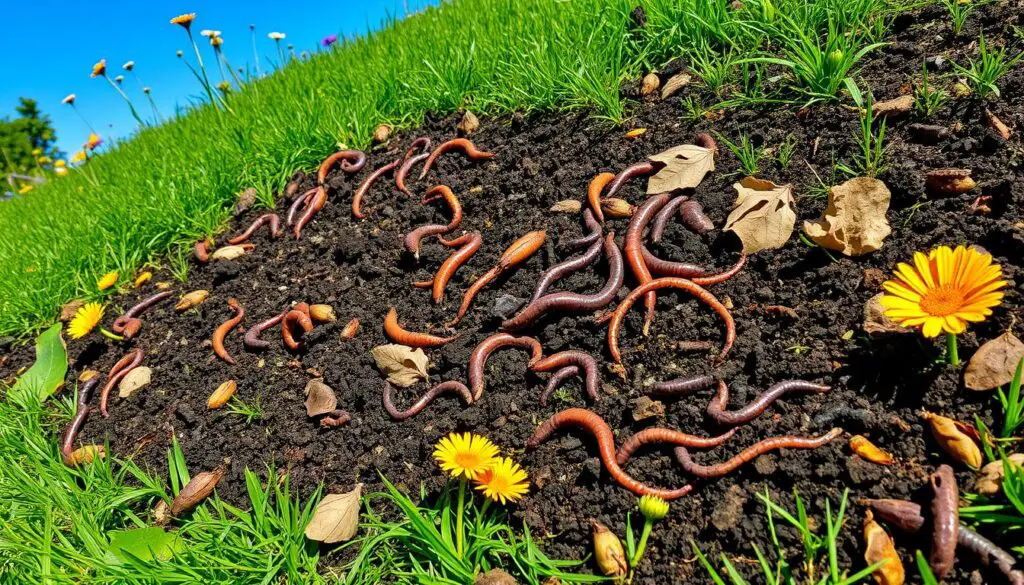
“Soil fertility management involves organic and inorganic approaches, with organic methods such as planting legumes, using manures, cover crops, and other natural farming techniques gaining popularity in recent years.”
Importance of Soil pH Balance
Keeping your lawn healthy starts with the right soil pH. Soil pH shows if it’s too acidic or alkaline. It affects how well plants grow, fight diseases, and absorb nutrients. By keeping the pH in check, your lawn will stay green and strong all year.
Effects of Imbalanced pH Levels
Soil pH that’s off can harm your lawn. Acidic soil (too low) makes nutrients hard for plants to get. It also makes some elements toxic. On the other hand, alkaline soil (too high) makes it tough for plants to get phosphorus and other important nutrients.
This imbalance can make your grass grow poorly, look unhealthy, and get sick more easily. It’s vital to keep the pH right so your lawn gets the nutrients it needs.
Maintaining Optimal pH Range
- Testing your soil regularly is the first step. You can do this through your local extension service or a simple kit. It’s best to test every 3-5 years.
- If your soil is too acidic, add lime to raise it. For too alkaline soil, use elemental sulfur to lower it.
- The best pH range for lawns is 6.2 to 6.8, with 7.0 being neutral. Keeping it in this range helps your grass grow well and fight off diseases.
Getting and keeping the right soil pH is key to a great lawn. By knowing how pH affects your lawn and taking steps to adjust it, you’ll have a lush, healthy lawn for years to come.
Proper Irrigation for soil health
Getting the right amount of water is key for a healthy lawn. Good irrigation helps water soak into the soil and stay there. It also supports root growth and keeps nutrients in the soil.
Consequences of Over/Under Watering
Finding the perfect balance in watering is essential. Overwatering can make the soil too wet, causing nutrients to wash away. It also harms the soil’s natural helpers.
Underwatering makes the soil dry. This makes it hard for roots to get the water and nutrients they need. It hurts plant growth.
- Dry soil can easily erode, losing valuable nutrients and topsoil.
- Soil needs the right moisture to keep its natural helpers healthy. These helpers break down organic matter and release nutrients.
- Good irrigation stops nutrients from washing away. This keeps the soil rich for plant health.
Knowing the right moisture level for your lawn helps. This way, your irrigation system gives the right amount of water. Your soil stays healthy, and your grass grows well.
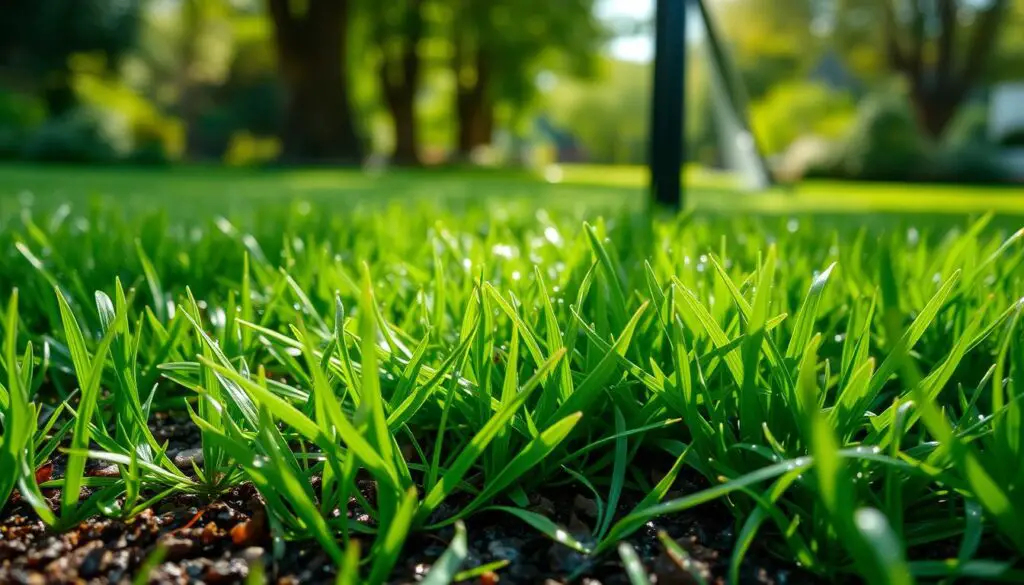
“Proper irrigation helps maintain soil moisture levels, promoting strong and deep root growth for healthy plants.”
Using smart irrigation tech, like moisture sensors and remote controls, is smart. It saves water and meets your lawn’s specific needs. This approach also keeps nutrients in the soil, improving overall health.
Choosing the Right Grass for Your Soil
Choosing the right grass is key to a lush lawn. Each grass type has its own soil preferences and needs. Let’s look at popular grasses for homes and how they match your soil.
Kentucky Bluegrass Preferences
Kentucky bluegrass is a cool-season grass species known for its lush look. It needs regular mowing, fertilizing, and watering to stay vibrant. It grows best in cooler areas with well-drained soil and the right pH.
Bermuda Grass Adaptability
Bermuda grass is a warm-season grass that adapts well to many soils. It’s great for busy areas and hot, humid places. It may turn brown in winter but can be kept green with ryegrass.
Tall Fescue’s Robust Roots
Tall fescue has deep roots, making it drought-tolerant. It’s good for areas with occasional poor drainage. It’s also low-maintenance, making it a favorite for easy lawns.
Choosing the right grass is crucial for a healthy lawn. It depends on your soil, climate, and how much care you want. By knowing what each grass needs, you can pick the best one for your lawn.
The Role of Aeration in Lawn Care
Keeping your lawn green and healthy is more than just mowing and watering. Soil aeration is a key part of lawn care that’s often missed. It can greatly improve your lawn’s health and look.
Benefits of Aerating Your Lawn
Soil compaction can slow down your grass’s growth. Aeration fixes this by improving how soil breathes, absorbs water, and gets nutrients. This leads to stronger roots and a thicker lawn.
- Enhances oxygen exchange in the soil, allowing grass roots to breathe and thrive.
- Improves water infiltration, reducing the risk of waterlogging and ensuring efficient moisture distribution.
- Increases nutrient uptake, helping your lawn utilize fertilizers and other soil amendments more effectively.
- Reduces thatch buildup, a layer of dead grass and debris that can inhibit growth.
Regular aeration, during the growing season, makes your lawn healthier and more vibrant. It helps your lawn deal with stress and environmental changes better.
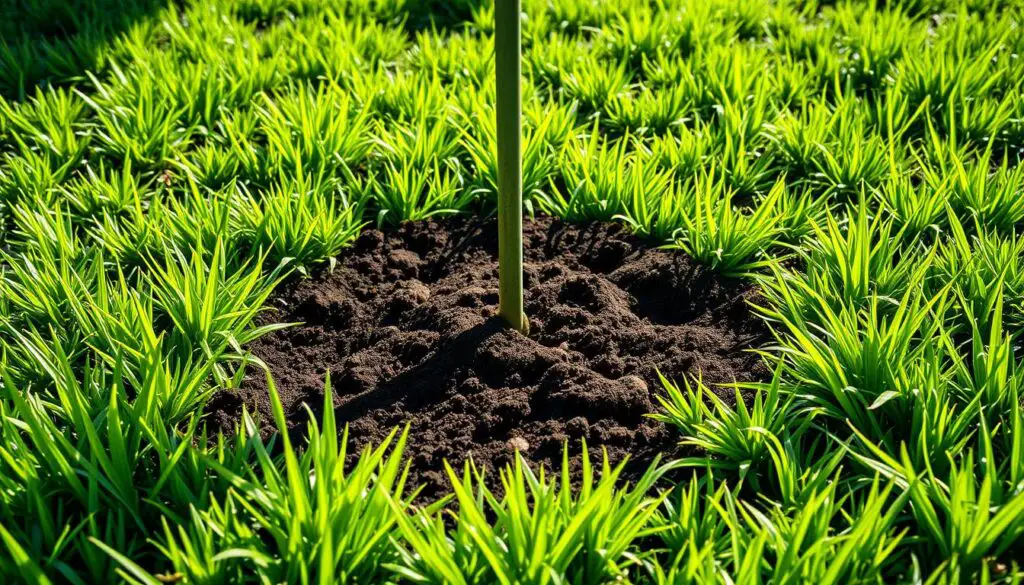
“Lawn aeration is essential for maintaining a thriving, verdant lawn. It’s a simple yet powerful tool that can transform the health and appearance of your outdoor space.”
Choosing between spike or plug aerators, adding aeration to your lawn care can make a big difference. It tackles soil compaction and improves soil conditions, helping you get the lawn you’ve always wanted.
| Benefit | Description |
|---|---|
| Improved Oxygen Exchange | Aeration creates channels in the soil, allowing for better air circulation and oxygen penetration, which is essential for healthy grass growth. |
| Enhanced Water Infiltration | The holes created by aeration help water penetrate the soil more effectively, reducing runoff and ensuring your lawn receives the moisture it needs. |
| Increased Nutrient Uptake | Aeration improves the soil’s ability to absorb and distribute essential nutrients, such as fertilizers, more efficiently to the grass roots. |
| Reduced Thatch Buildup | Aeration helps break down the layer of dead grass and debris known as thatch, which can prevent water, air, and nutrients from reaching the soil. |
Implementing a Fertilization Plan
To keep your lawn looking great, you need a good fertilization plan. This plan should match your soil, grass type, and local weather. The main goal is to give your lawn the nutrients it needs for healthy growth and strong roots.
Providing Essential Nutrients
Lawn fertilizers have important nutrients like macronutrients and micronutrients. Macronutrients include nitrogen (N), phosphorus (P), and potassium (K). Micronutrients like iron and magnesium help with plant health. Finding the right nutrient balance is key for a thriving lawn.
- Nitrogen (N) fuels lush, green foliage growth.
- Phosphorus (P) supports strong root development.
- Potassium (K) enhances disease and drought resistance.
- Micronutrients like iron and magnesium play crucial roles in chlorophyll production and overall plant health.
When choosing fertilizers, you can pick between organic fertilizers and synthetic fertilizers. Organic fertilizers help the soil over time. Synthetic fertilizers give a quick nutrient boost.
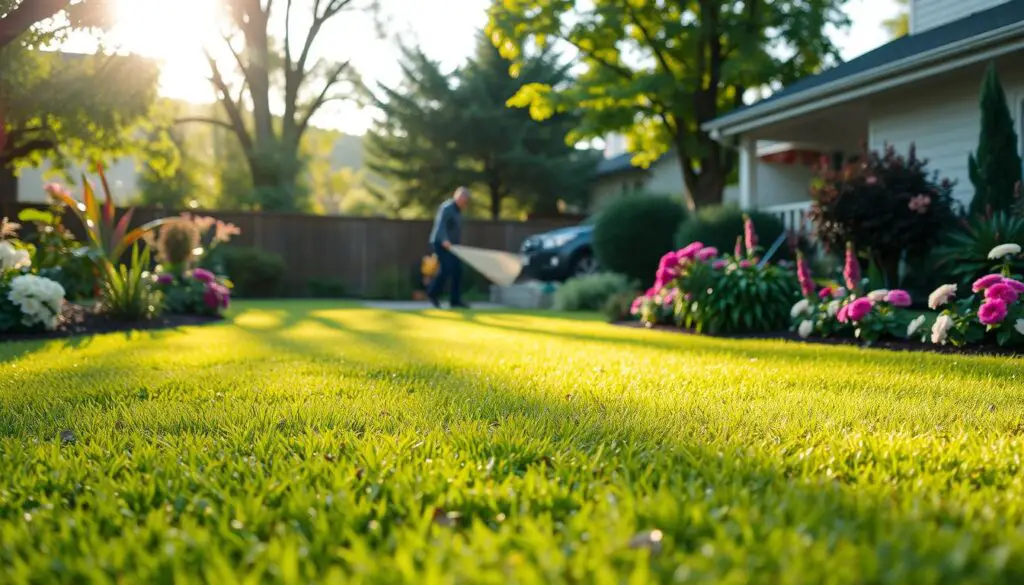
The Inflation Reduction Act will give $19.5 billion for climate-smart agriculture. This includes better nutrient management. The NRCS offers free help to improve how you manage nutrients.
Soil Health and Lawn Resilience
Healthy soil is essential for a lush, resilient lawn. It helps the lawn fight off environmental stresses and grow all year. By improving soil health, I can make my lawn more drought-resistant, disease-resistant, and pest-resistant. This means I need to use fewer chemicals, making my lawn care more eco-friendly.
Sup-R-Soil has been a big help in my lawn care. It adds important nutrients, boosts microbes, and holds water better. My grass now has stronger, deeper roots. This lets it get more water and nutrients, helping it grow stronger.
With Sup-R-Soil, my lawn can handle heat, drought, and foot traffic better. The healthier soil also helps my lawn fight weeds and pests. This way, I use fewer chemicals, creating a lush lawn that’s good for the environment.

